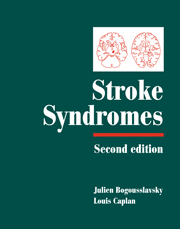Book contents
- Frontmatter
- Contents
- List of contributors
- Preface
- PART I CLINICAL MANIFESTATIONS
- PART II VASCULAR TOPOGRAPHIC SYNDROMES
- 29 Arterial territories of human brain
- 30 Superficial middle cerebral artery syndromes
- 31 Lenticulostriate arteries
- 32 Anterior cerebral artery
- 33 Anterior choroidal artery territory infarcts
- 34 Thalamic infarcts and hemorrhages
- 35 Caudate infarcts and hemorrhages
- 36 Posterior cerebral artery
- 37 Large and panhemispheric infarcts
- 38 Multiple, multilevel and bihemispheric infarcts
- 39 Midbrain infarcts
- 40 Pontine infarcts and hemorrhages
- 41 Medullary infarcts and hemorrhages
- 42 Cerebellar stroke syndromes
- 43 Extended infarcts in the posterior circulation (brainstem/cerebellum)
- 44 Border zone infarcts
- 45 Classical lacunar syndromes
- 46 Putaminal hemorrhages
- 47 Lobar hemorrhages
- 48 Intraventricular hemorrhages
- 49 Subarachnoid hemorrhage syndromes
- 50 Brain venous thrombosis syndromes
- 51 Carotid occlusion syndromes
- 52 Cervical artery dissection syndromes
- 53 Syndromes related to large artery thromboembolism within the vertebrobasilar system
- 54 Spinal stroke syndromes
- Index
- Plate section
31 - Lenticulostriate arteries
from PART II - VASCULAR TOPOGRAPHIC SYNDROMES
Published online by Cambridge University Press: 17 May 2010
- Frontmatter
- Contents
- List of contributors
- Preface
- PART I CLINICAL MANIFESTATIONS
- PART II VASCULAR TOPOGRAPHIC SYNDROMES
- 29 Arterial territories of human brain
- 30 Superficial middle cerebral artery syndromes
- 31 Lenticulostriate arteries
- 32 Anterior cerebral artery
- 33 Anterior choroidal artery territory infarcts
- 34 Thalamic infarcts and hemorrhages
- 35 Caudate infarcts and hemorrhages
- 36 Posterior cerebral artery
- 37 Large and panhemispheric infarcts
- 38 Multiple, multilevel and bihemispheric infarcts
- 39 Midbrain infarcts
- 40 Pontine infarcts and hemorrhages
- 41 Medullary infarcts and hemorrhages
- 42 Cerebellar stroke syndromes
- 43 Extended infarcts in the posterior circulation (brainstem/cerebellum)
- 44 Border zone infarcts
- 45 Classical lacunar syndromes
- 46 Putaminal hemorrhages
- 47 Lobar hemorrhages
- 48 Intraventricular hemorrhages
- 49 Subarachnoid hemorrhage syndromes
- 50 Brain venous thrombosis syndromes
- 51 Carotid occlusion syndromes
- 52 Cervical artery dissection syndromes
- 53 Syndromes related to large artery thromboembolism within the vertebrobasilar system
- 54 Spinal stroke syndromes
- Index
- Plate section
Summary
Anatomy
There are usually two medial and four or five lateral lenticulostriate arteries (Rosner et al., 1984) (Fig. 31.1). and these divide to give an average of 26 branches on penetrating the brain (Marinkovic et al.,1985a)(Fig. 31.2). The lateral lenticulostriates are twice the diameter of the medial ones and are longer. The medial lenticulostriates supply the more medial deep MCA territory (lateral globus pallidus, medial putamen, whereas the lateral lenticulostriates supply the lateral putamen and external capsule, and the upper internal capsule (Herman et al., 1963) up to the white matter of the coronaradiata (De Reuck, 1969; Donzelli et al., 1998). Up to 50% of penetrating arteries arise from a common stem (Fig. 31.3), and occasionally a single common stem gives rise to all lenticulostriates (Umansky et al., 1985; Vincentelli et al., 1990). The ramification zone of the lenticulostriates has been measured on a methacrylic resin cast of the perforating arteries (Marinkovic et al., 1985b). On the basis of these measurements, occlusion of a medial lenticulostriate or of the distal branches of a lateral lenticulostriate artery is likely to give an infarct within the accepted limit of a lacunar infarct (15mm diameter). Occlusion of a single lateral lenticulostriate proximally however, or of a common stem giving rise to two or more lenticulostriates, is likely to give an infarct considerably larger than the accepted dimensions of a lacunar infarct.
- Type
- Chapter
- Information
- Stroke Syndromes , pp. 428 - 438Publisher: Cambridge University PressPrint publication year: 2001
- 6
- Cited by



